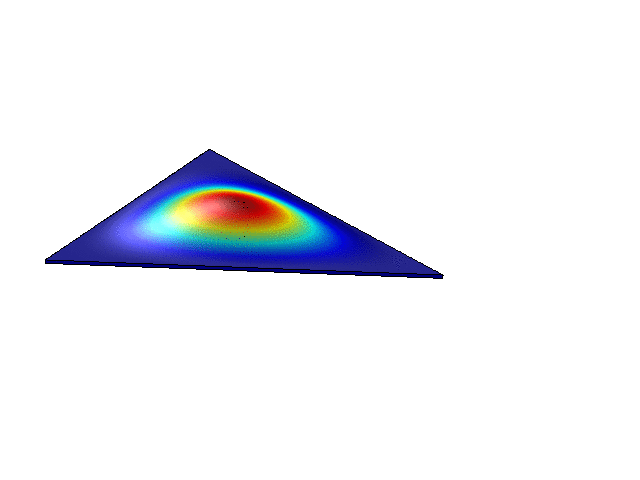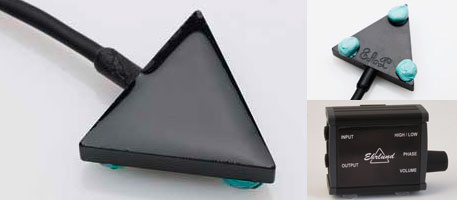
 |
|
#1
|
|||
|
|||
|
Hi everyone,
I am experimenting with piezo discs. I was wondering why the TA amulet, Dazzo or HFN sound different. So I made a dummy experiment. I record my old Yamaha FG with a piezo disc. * I played with position * Sometimes I added a Lego piece between the pickup and the top. I tried different shapes and a red triange which is 3-D print to the Dazzo pickup dimensions. Here are my 2 cents: * The closer to the saddle the thinner the tone (listen to the high strings) * The Lego pieces have their own resonances that color the sound. Note that pickups (Amulet, Dazzo) would probably have the piezo inside the enclosure making a mix between the direc sound from the top and the resonances from the enclosure. This is not a scientific experiment... so please don't fire at me. I am curious if you have the same interpretation.
__________________
Martin 00-18V Goldplus + internal mic (2003) Martin OM-28V + HFN + internal mic (1999) Eastman E6OM (2019) Trance Audio Amulet Yamaha FGX-412 (1998) Gibson Les Paul Standard 1958 Reissue (2013) Fender Stratocaster American Vintage 1954 (2014) http://acousticir.free.fr/ |
|
#2
|
||||
|
||||
|
I will chime in here and say that I don't know what's inside the pickups you mention, so I can't comment on how any of these experiments apply.
I will state a few things that might not be common knowledge:

__________________
James May Audio Sprockets maker of ToneDexter James May Engineering maker of the Ultra Tonic Pickup |
|
#3
|
|||
|
|||
|
Quote:
it totally makes sens to me now. I don't know anything about piezo and I am learning with that little DIY project. I also just read Peterman's pickup  It explains also why the lego bridge is always louder... (I also did experiments with a plastic plate and an exciter and this was obvious) As far the material over it, there are some really interesting experiments: Different materials over piezo discs It's fascinating!
__________________
Martin 00-18V Goldplus + internal mic (2003) Martin OM-28V + HFN + internal mic (1999) Eastman E6OM (2019) Trance Audio Amulet Yamaha FGX-412 (1998) Gibson Les Paul Standard 1958 Reissue (2013) Fender Stratocaster American Vintage 1954 (2014) http://acousticir.free.fr/ Last edited by Cuki79; 04-02-2019 at 03:48 PM. |
|
#4
|
|||
|
|||
|
Very interesting experiment. Unless Iím wrong it appears that there are no definitive conclusions.
__________________
Taylor V-Class 814ce, 717e BE WHB, 520ce, 454ce, 420 Cedar\Maple, T5z Classic Martin D18E Retro Cordoba C10 Crossover Emerald X20 Rainsong H-OM1000N2 Voyage-Air VAD-04 Custom Les Paul Hot Rod Deville 410, Fishman Loudbox Performer |
|
#5
|
|||
|
|||
|
Quote:
Here is a barcus berry pickup. The piezo element seems suspended.  The HFN might be a variation of the same idea, suspend the piezo to excite a certain bending mode.
__________________
Martin 00-18V Goldplus + internal mic (2003) Martin OM-28V + HFN + internal mic (1999) Eastman E6OM (2019) Trance Audio Amulet Yamaha FGX-412 (1998) Gibson Les Paul Standard 1958 Reissue (2013) Fender Stratocaster American Vintage 1954 (2014) http://acousticir.free.fr/ |
|
#6
|
|||
|
|||
|
Some of the best pickup research is being done right here on AGF. Thanks Cuki and James and those willing to glue instead of tape. We're all learning from your work.
__________________
Steve Mcilroy A25c (Cedar, English Walnut) with Schatten HFN (custom MiSi Crystal Jack Preamp, putty install.) Maton 75th Anniversary OM 50th Anniversary Fender Am Std Strat. Gretsch 6120 Nashville Players in Blue. Line 6 Helix. If I played as much as I read threads, I'd be a pro.... |
|
#7
|
|||
|
|||
|
I do know from Talking to Teddy Randazzo of Dazzo (also formerly FRAP) fame, he says that Piezo crystal is not he same. Every piezo source is a bit different sounding. Teddy spent years trying various sources of piezo crystal until he found the one that sounds the best to him. I am sure this was a consideration, or should be a consideration for every piezo pickups maker. Again, piezo material differs in the resulting tone.
Yes, some pickup makers attach their piezo crystal to a different substance. Some are on brass plates, some are on wood or plastic, and some are in enclosures. They all have an effect on tone. The variables are endless. If Dieter, Teddy or any other creator/designer of pickups did their homework of time, testing and consideration of all these variables, they most likely came up with what sounds best to them.
__________________
Vancebo Husband of One, Father of Two Worship Leader, Music Teacher Oregon Duck Fan Guitars by: Collings, Bourgeois, Taylor Pickups by: Dazzo Preamps by: Sunnaudio Amps by: Bose (S1) Grateful 
|
|
#8
|
|||
|
|||
|
Quote:
However It's funny to explore some of the solutions by myself. I
__________________
Martin 00-18V Goldplus + internal mic (2003) Martin OM-28V + HFN + internal mic (1999) Eastman E6OM (2019) Trance Audio Amulet Yamaha FGX-412 (1998) Gibson Les Paul Standard 1958 Reissue (2013) Fender Stratocaster American Vintage 1954 (2014) http://acousticir.free.fr/ |
|
#9
|
|||
|
|||
|
I made some FEM simulations.
I compute the resonant modes of a brass plate with a disc shape. I supposed that the border were fixed (think Peterman's design) With the size of the disc I've used in the video I get a resonance around 7.6 Khz  I did a similar simulation with a triangle of the size of a Dazzo pickup. (note again that I suppose the brass plate to be hold at the sides)  I get 14 KHz!!! The bandwidth of a Bose L1c!! As a reminder from the wikipedia page for piezo sensor, we learn that the pickup works for the frequencies below the main resonance. 
__________________
Martin 00-18V Goldplus + internal mic (2003) Martin OM-28V + HFN + internal mic (1999) Eastman E6OM (2019) Trance Audio Amulet Yamaha FGX-412 (1998) Gibson Les Paul Standard 1958 Reissue (2013) Fender Stratocaster American Vintage 1954 (2014) http://acousticir.free.fr/ |
|
#10
|
||||
|
||||
|
Let's remember that the resonance you are calculating is only valid when the edges are held fixed, and the field is free to vibrate. In practical applications as pickups, that is never the case. In the kind of practical pickups I know about using piezo benders, the resonances are far above audio.
None the less, it is impressive that you were able to come up with a resonance figure via Finite Element Analysis that is very similar to what is published by the piezo vendors.
__________________
James May Audio Sprockets maker of ToneDexter James May Engineering maker of the Ultra Tonic Pickup |
|
#11
|
|||
|
|||
|
Quote:
I also thought about side hanging because of the ehrlund pickup (European patent for the triangular shape pickup) 
__________________
Martin 00-18V Goldplus + internal mic (2003) Martin OM-28V + HFN + internal mic (1999) Eastman E6OM (2019) Trance Audio Amulet Yamaha FGX-412 (1998) Gibson Les Paul Standard 1958 Reissue (2013) Fender Stratocaster American Vintage 1954 (2014) http://acousticir.free.fr/ |
|
#12
|
|||
|
|||
|
Not unlike green m&ms I found the green
lego most exciting.  . . Seriously though if the freedom to move is important would not crazy glue restrict a piezos movement more than tape more than putty? |
|
#13
|
|||
|
|||
|
Quote:
For me as soon as you glue/tape the whole sensor: you mechanically load it and change its mechanical properties and resonance. It becomes a whole different system. I honestly have no idea how the piezo behave once it is fully glued to the top. I guess the pickup has negligible effect on the top vibration, and probably the top fully drive the pickup so it’s own resonance disappears from the equation... I have no idea honestly. James would know better. I like the idea of a suspended oscillator. (Barcus Berry? Peterman...?) Somehow the Baggs Lyric has the same idea, the condenser mic is a lightweight suspended membrane that senses both air and top vibrations.
__________________
Martin 00-18V Goldplus + internal mic (2003) Martin OM-28V + HFN + internal mic (1999) Eastman E6OM (2019) Trance Audio Amulet Yamaha FGX-412 (1998) Gibson Les Paul Standard 1958 Reissue (2013) Fender Stratocaster American Vintage 1954 (2014) http://acousticir.free.fr/ |
|
#14
|
|||
|
|||
|
Hi everyone,
I tried a dummy experiment. Again, here the sensors are not glued so the properties of the sensor count. Once mechanically loaded by glueing... I can't say. First I try the piezo disc then the PVDF film. The PVDF film needs much more gain and is very EMI sensitive therefore the 50 Hz hum (I am in Europe). Challenge for a company like PUTW is to shield those things without damping them too much I guess. The very low mass of the PVDF film gives an extended high end. That's my interpretation but again... I could be wrong. Note that depending how I hold the PVDF film against the guitar, I could definitely experience distortion and weird sound as previously reported by Doug Young with PUTW #54.
__________________
Martin 00-18V Goldplus + internal mic (2003) Martin OM-28V + HFN + internal mic (1999) Eastman E6OM (2019) Trance Audio Amulet Yamaha FGX-412 (1998) Gibson Les Paul Standard 1958 Reissue (2013) Fender Stratocaster American Vintage 1954 (2014) http://acousticir.free.fr/ |
|
#15
|
|||
|
|||
|
Quote:
__________________
Martin HD-28 Sunburst/Trance M-VT Phantom Martin D-18/UltraTonic Adamas I 2087GT-8 Ovation Custom Legend LX Guild F-212XL STD Huss & Dalton TD-R Taylor 717e Taylor 618e Taylor 614ce Larrivee D-50M/HiFi Larrivee D-40R Blue Grass Special/HiFi Larrivee D-40R Sunburst Larrivee C-03R TE/Trance M-VT Phantom RainSong BI-DR1000N2 Emerald X20 Yamaha FGX5 Republic Duolian/Schatten NR-2 |